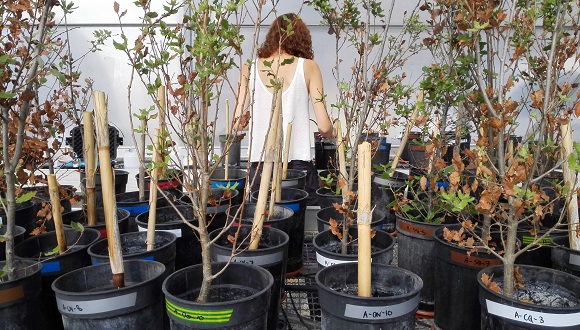Once rehydrated, holm oaks have a large capacity for recovery thanks to their high adaptation to the Mediterranean climate. The release of organic compounds into the soil represents a considerable loss of carbon for the holm oak and also modifies the microbial community, which may lead to additional effects on the tree.

Researchers from CREAF have shown that during intense droughts the amount of carbon lost through roots is 21% higher than normal. This carbon is released in the form of exudates, substances that plants also release under normal conditions. During intense droughts, most of the carbon in the exudates comes from dead and damaged roots whose cells break down and release their contents into the environment. During moderate droughts, on the other hand, “levels of exudation which are higher than normal can actually be a good adaptation in order to save the roots. For example, the secretion of some substances lubricates the roots and facilitates exploration in the soil for water at deeper depths. There are also exudates that make soil nutrients more available to the plant,” explains Catherine Preece, CREAF researcher and lead author of the study that was published in Tree Physiology.
The secretion of some substances lubricates the roots and facilitates exploration in the soil for water at deeper depths. There are also exudates that make soil nutrients more available to the plant.
Whatever the case, exudation represents a large loss of carbon for the plant, which then needs to carry out more photosynthesis in order to replenish the lost sugars and recover resources. This is a particularly delicate matter during droughts since photosynthesis requires a significant amount of water.

The study was carried out in greenhouses where different levels of water scarcity were simulated with the holm oaks. In all of the treatments the holm oaks showed a high capacity for recovering normal levels of exudation – an ability which is very useful in the context of climate change. The holm oak was specifically chosen for the experiments since it is a tree which is representative of the Mediterranean Basin and is highly adapted to its climate and droughts.
In all of the treatments the holm oaks showed a high capacity for recovering normal levels of exudation - an ability which is very useful in the context of climate change.
Another important effect of these these exudates, some of them containing carbon, is that which they have on microbial community composition and activity in the rhizosphere – the area of soil surrounding roots. “The carbon in root exudates is a very important source of energy for bacteria and fungi in the soil. If the exudates increase this can signify an increase in the activity of these microorganisms, which translates into greater decomposition and loss of soil organic matter. So, something that on one hand may be bad for the plant can benefit the soil in the short term”, says Preece.

“With this work we were able to advance knowledge about root exudates, which, despite their importance, up to know have gone largely unnoticed due to the fact that they are underground, out of our sight,” says Josep Penuelas, director of the study.
ARTICLE
Preece C., Farré-Armengol G., Llusià J., Peñuelas J. (2018). Thirsty tree roots exude more carbon. Tree Physiology. DOI: 10.1093/treephys/tpx163







